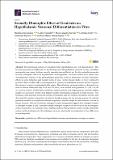Por favor, use este identificador para citar o enlazar a este item:
http://hdl.handle.net/10261/182963COMPARTIR / EXPORTAR:
 SHARE SHARE
 CORE
BASE CORE
BASE
|
|
| Visualizar otros formatos: MARC | Dublin Core | RDF | ORE | MODS | METS | DIDL | DATACITE | |

| Título: | Sexually dimorphic effect of genistein on hypothalamic neuronal differentiation in vitro |
Autor: | Marraudino, Marilena; Farinetti, Alice; Arévalo, María Ángeles CSIC ORCID ; Gotti, Stefano; Panzica, G.; García-Segura, Luis M. CSIC ORCID | Palabras clave: | Genistein Sex differences Hypothalamic neurons Neuritogenesis Estrogen receptors |
Fecha de publicación: | 18-may-2019 | Editor: | Multidisciplinary Digital Publishing Institute | Citación: | International Journal of Molecular Sciences 20(10): 2465 (2019) | Resumen: | Developmental actions of estradiol in the hypothalamus are well characterized. This hormone generates sex differences in the development of hypothalamic neuronal circuits controlling neuroendocrine events, feeding, growth, reproduction and behavior. In vitro, estradiol promotes sexually dimorphic effects on hypothalamic neuritogenesis. Previous studies have shown that developmental actions of the phytoestrogen genistein result in permanent sexually dimorphic effects in some behaviors and neural circuits in vivo. In the present study, we have explored if genistein, like estradiol, affects neuritogenesis in primary hypothalamic neurons and investigated the estrogen receptors implicated in this action. Hypothalamic neuronal cultures, obtained from male or female embryonic day 14 (E14) CD1 mice, were treated with genistein (0.1 µM, 0.5 µM or 1 µM) or vehicle. Under basal conditions, female neurons had longer primary neurites, higher number of secondary neurites and higher neuritic arborization compared to male neurons. The treatment with genistein increased neuritic arborization and the number of primary neurites and decreased the number of secondary neurites in female neurons, but not in male neurons. In contrast, genistein resulted in a significant increase in primary neuritic length in male neurons, but not in female neurons. The use of selective estrogen receptor antagonists suggests that estrogen receptor α, estrogen receptor β and G-protein-coupled estrogen receptors are involved in the neuritogenic action of genistein. In summary, these findings indicate that genistein exerts sexually dimorphic actions on the development of hypothalamic neurons, altering the normal pattern of sex differences in neuritogenesis. | Descripción: | © The Author(s). | Versión del editor: | https://doi.org/10.3390/ijms20102465 | URI: | http://hdl.handle.net/10261/182963 | DOI: | 10.3390/ijms20102465 | ISSN: | 1661-6596 | E-ISSN: | 1422-0067 |
| Aparece en las colecciones: | (IC) Artículos |
Ficheros en este ítem:
| Fichero | Descripción | Tamaño | Formato | |
|---|---|---|---|---|
| Sexually_Marraudino _Art2019.pdf | 1,44 MB | Adobe PDF |  Visualizar/Abrir |
CORE Recommender
PubMed Central
Citations
3
checked on 23-abr-2024
SCOPUSTM
Citations
10
checked on 19-abr-2024
WEB OF SCIENCETM
Citations
9
checked on 26-feb-2024
Page view(s)
166
checked on 24-abr-2024
Download(s)
201
checked on 24-abr-2024

